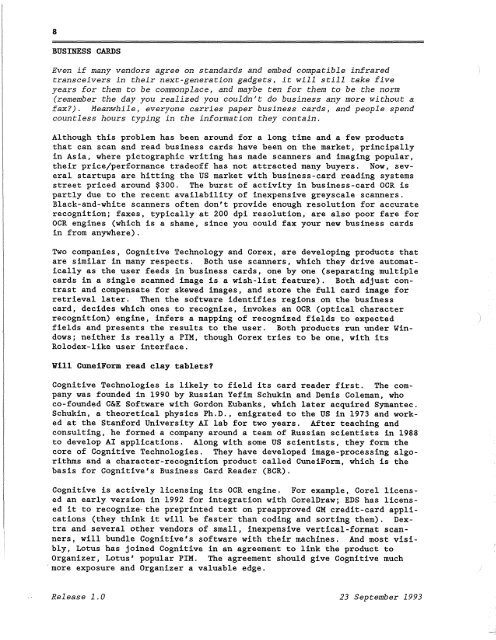23 September 1993 - Cdn.oreilly.com
23 September 1993 - Cdn.oreilly.com
23 September 1993 - Cdn.oreilly.com
Create successful ePaper yourself
Turn your PDF publications into a flip-book with our unique Google optimized e-Paper software.
8<br />
BUSINESS CARDS<br />
Even if many vendors agree on standards and embed <strong>com</strong>patible infrared<br />
transceivers in their next-generation gadgets, it will still take five<br />
years for them to be <strong>com</strong>monplace, and maybe ten for them to be the norm<br />
(remember the day you realized you couldn't do business any more without a<br />
fax?). Meanwhile, everyone carries paper business cards, and people spend<br />
countless hours typing in the information they contain.<br />
Although this problem has been around for a long time and a few products<br />
that can scan and read business cards have been on the market, principally<br />
in Asia, where pictographic writing has made scanners and imaging popular,<br />
their price/performance tradeoff has not attracted many buyers. Now, several<br />
startups are hitting the US market with business-card reading systems<br />
street priced around $300. The burst of activity in business-card OCR is<br />
partly due to the recent availability of inexpensive greyscale scanners.<br />
Black-and-white scanners often don't provide enough resolution for accurate<br />
recognition; faxes, typically at 200 dpi resolution, are also poor fare for<br />
OCR engines (which is a shame, since you could fax your new business cards<br />
in from anywhere).<br />
Two <strong>com</strong>panies, Cognitive Technology and Corex, are developing products that<br />
are similar in many respects. Both use scanners, which they drive automatically<br />
as the user feeds in business cards, one by one (separating multiple<br />
cards in a single scanned image is a wish-list feature). Both adjust contrast<br />
and <strong>com</strong>pensate for skewed images, and store the full card image for<br />
retrieval later. Then the software identifies regions on the business<br />
card, decides which ones to recognize, invokes an OCR (optical character<br />
recognition) engine, infers a mapping of recognized fields to expected<br />
fields and presents the results to the user. Both products run under Windows;<br />
neither is really a PIM, though Corex tries to be one, with its<br />
Rolodex-like user interface.<br />
Will CuneiForm read clay tablets?<br />
Cognitive Technologies is likely to field its card reader first. The <strong>com</strong>pany<br />
was founded in 1990 by Russian Yefim Schukin and Denis Coleman, who<br />
co-founded C&E Software with Gordon Eubanks, which later acquired Symantec.<br />
Schukin, a theoretical physics Ph.D., emigrated to the US in 1973 and worked<br />
at the Stanford University AI lab for two years. After teaching and<br />
consulting, he formed a <strong>com</strong>pany around a team of Russian scientists in 1988<br />
to develop AI applications. Along with some US scientists, they form the<br />
core of Cognitive Technologies. They have developed image-processing algorithms<br />
and a character-recognition product called CuneiForm, which is the<br />
basis for Cognitive's Business Card Reader (BCR).<br />
Cognitive is actively licensing its OCR engine. For example, Corel licensed<br />
an early version in 1992 for integration with CorelDraw; EDS has licensed<br />
it to recognize the preprinted text on preapproved GM credit-card applications<br />
(they think it will be faster than coding and sorting them). Dextra<br />
and several other vendors of small, inexpensive vertical-format scanners,<br />
will bundle Cognitive's software with their machines. And most visibly,<br />
Lotus has joined Cognitive in an agreement to link the product to<br />
Organizer, Lotus' popular PIM. The agreement should give Cognitive much<br />
more exposure and Organizer a valuable edge.<br />
Release 1.0 <strong>23</strong> <strong>September</strong> <strong>1993</strong>

















